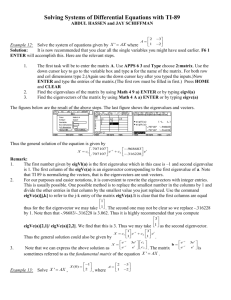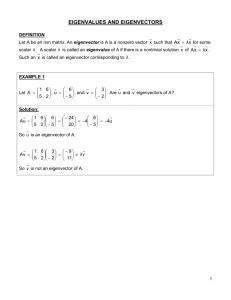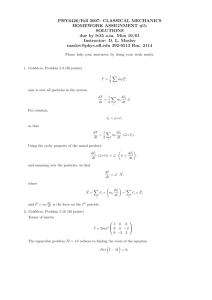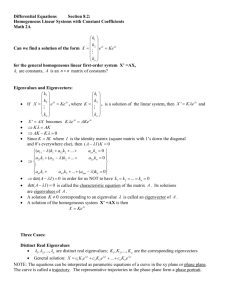11.2 Stability of Linear Systems
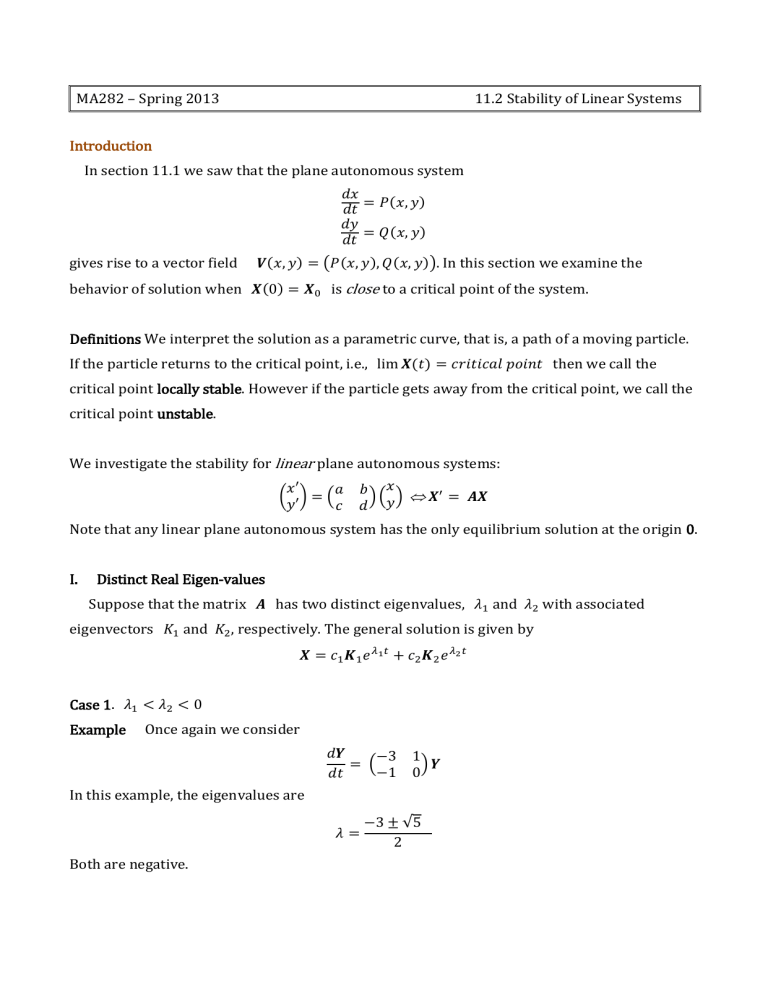
MA282 – Spring 2013 11.2 Stability of Linear Systems
Introduction
In section 11.1 we saw that the plane autonomous system 𝑑𝑥 𝑑𝑡 𝑑𝑦 𝑑𝑡
= 𝑃(𝑥, 𝑦)
= 𝑄(𝑥, 𝑦) gives rise to a vector field 𝑽(𝑥, 𝑦) = (𝑃(𝑥, 𝑦), 𝑄(𝑥, 𝑦)). In this section we examine the behavior of solution when 𝑿(0) = 𝑿
0
is close to a critical point of the system.
Definitions We interpret the solution as a parametric curve, that is, a path of a moving particle.
If the particle returns to the critical point, i.e., lim𝑿(𝑡) = 𝑐𝑟𝑖𝑡𝑖𝑐𝑎𝑙𝑝𝑜𝑖𝑛𝑡 then we call the critical point locally stable. However if the particle gets away from the critical point, we call the critical point unstable.
We investigate the stability for linear plane autonomous systems:
( 𝑥′ 𝑦′
) = ( 𝑎 𝑏 𝑐 𝑑
) ( 𝑥 𝑦)
𝑿 ′ = 𝑨𝑿
Note that any linear plane autonomous system has the only equilibrium solution at the origin 0.
I. Distinct Real Eigen-values
Suppose that the matrix 𝑨 has two distinct eigenvalues, 𝜆
1
and𝜆
2
with associated eigenvectors 𝐾
1
and𝐾
2
, respectively. The general solution is given by
𝑿 = 𝑐
1
𝑲
1 𝑒 𝜆
1 𝑡 + 𝑐
2
𝑲
2 𝑒 𝜆
2 𝑡
Case 1. 𝜆
1
< 𝜆
2
< 0
Example Once again we consider 𝑑𝒀 𝑑𝑡
= (
−3 1
−1 0
) 𝒀
In this example, the eigenvalues are 𝜆 =
−3 ± √5
2
Both are negative.
The slope of the eigenline thatcorrespondstothe“fast”eigenvalue 𝜆
1
= (−3 − √5)/2 is approximately 0.4; the slope of the eigenline thatcorrespondstothe“slow”eigenvalue 𝜆
2
=
(−3 + √5)/2 is approximately 2.6.
All solutions tend to the origin. A critical point is called a stable node.
Once we understand the phase portrait we can sketch the component graphs by hand.
Let’s sketch the 𝑥(𝑡) − and 𝑦(𝑡) −graphs that correspond to the initial conditions (−3, 2)
And (3, 2) for 𝑑𝒀 𝑑𝑡
= (
−3 1
−1 0
) 𝒀
Case 2. 𝜆
1
< 0 < 𝜆
2
Example Consider 𝑑𝒀 𝑑𝑡
= (
4 −5
) 𝒀
−2 1
The eigenvalues are 𝜆
1
= −1,𝜆
2
= 6
The slope of the eigenline thatcorrespondstothe“slow”eigenvalue 𝜆
1
= −1is 1; the slope of the eigenline thatcorrespondstothe“fast”eigenvalue 𝜆
2
= 6 is −2/5.
All solutions come from ∞ and approach 0 along the line determined by the eigenvector 𝑲
1 and tend back to ∞ along the line determined by the eigenvector 𝑲
2
. This unstable critical point is called a saddle point.
Case 3. 0 < 𝜆
1
< 𝜆
2
Example Consider 𝑑𝒀 𝑑𝑡
= (
3 −1
1 0
) 𝒀
The eigenvalues are 𝜆 =
3 ± √5
2
The slope of the eigenline thatcorrespondstothe“slow”eigenvalue 𝜆
1
= (3 − √5)/2 is approximately 2.62; the slope of the eigenline thatcorrespondstothe“fast”eigenvalue 𝜆
2
=
(3 + √5)/2 is approximately 0.38.
All solutions tend away from the origin. This type of critical point, corresponding to the case when both eigenvalues are positive, is called an unstable node.
Case 4. 𝜆
1
≠ 0, 𝜆
2
= 0
Example Consider 𝑑𝒀 𝑑𝑡
= (
−2 1
2 −1
) 𝒀,𝒀(0) = (
3
0
)
The eigenvalues are 𝜆 = −3, 0
The slope of the eigenline that corresponds to 𝜆
1
= −3 is −1; the slope of the eigenline that corresponds to 𝜆
2
= 0 is 2.
Phase Portrait: x- and y- graphs:
II. Repeated Eigen-value
Suppose that the matrix 𝑨 has a repeated eigenvalue λ
1
.
(a) Two linearly independent eigenvectors
If 𝐾
1
and𝐾
2
are two linearly independent eigenvectors, the general solution is given by
𝑿 = 𝑐
1
𝑲
1 𝑒 𝜆
1 𝑡 + 𝑐
2
𝑲
2 𝑒 𝜆
1 𝑡 = (𝑐
1
𝑲
1
+ 𝑐
2
𝑲
2
)𝑒 𝜆
1 𝑡
If λ
1
< 0 then X( t) approaches 0 along the line determined by the vector 𝑐
1
𝑲
1
+ 𝑐
2
𝑲
2 and the critical point is called a degenerate stable node.
When λ
1
> 0. the arrows are and we have a degenerate unstable node.
(b) A single linearly independent eigenvector
When only a single linearly independent eigenvector 𝑲
1
exists, the general solution is given by
𝑿 = 𝑐
1
𝑲
1 𝑒 𝜆
1 𝑡 + 𝑐
2
(𝑲
1 𝑡𝑒 𝜆
1 𝑡 + 𝑷𝑒 𝜆
1 𝑡 ) where (𝐀 − λ
1
𝐈)𝐏 = 𝐊
1
.
If λ
1
< 0 then lim t→∞ 𝑡𝑒 𝜆
1 𝑡 = 0and it follows that 𝑿(𝑡) approaches 0 in one of the directions determined by the vector 𝑲
1
.
When λ
1
> 0, the solutions look like those in the figure above with the arrows reversed. The
critical point is again called a degenerate unstable node.
III. Complex Eigenvalues
If 𝜆
1
= 𝛼 + 𝛽𝑖is a complex eigenvalue and 𝑲
𝟏
is a complex eigenvector corresponding to 𝜆
1
, the general solution can be written as
𝑿 = 𝑐
1
Re𝑿
1
+ 𝑐
2
Im𝑿
1 where 𝐗
1
= 𝐊
1 e λ
1 t = 𝐊
1 𝑒 𝛼 (cos𝛽𝑡 + 𝑖sin𝛽𝑡).
(a) If 𝛼 > 0, 𝑒 𝛼𝑡 increases as 𝑡 → ∞, and the solutions spiral away from the origin. The critical point is called a unstable spiral point.
(b) If 𝛼 < 0, 𝑒 𝛼𝑡 decreases as 𝑡 → ∞, and the solutions spiral toward the origin. The critical point is called a stable spiral point.
(c) If 𝛼 = 0, the solutions are periodic. The critical point (0, 0) is called a center.
𝐄𝐱𝐚𝐦𝐩𝐥𝐞Classify the critical point (0, 0) of each of the following linear systems 𝑿 ′ = 𝑨𝑿.
(a) 𝑨 = (
3 −18
2 −9
) (b) 𝑨 = (
−1 2
−1 1
)
In each case discuss the nature of the solution that satisfies 𝑿(0) = (1, 0). Determine parametric equations for each solution.







